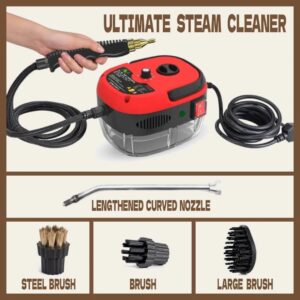
With Commercial cleaning equipment leading the way, a world of cleanliness and efficiency unfolds before us. In today’s fast-paced environments, maintaining pristine spaces is essential not just for aesthetics but for health and productivity as well.
This exploration delves into the various components, types, and innovations in commercial cleaning equipment, revealing how these tools enhance operations across diverse industries. From eco-friendly solutions to the latest technological advancements, the right cleaning equipment can transform any workspace.
Overview of Commercial Cleaning Equipment
Commercial cleaning equipment plays a crucial role in maintaining cleanliness and hygiene in various industries. This specialized equipment is designed to handle larger spaces and more demanding cleaning tasks than typical household cleaning tools, making it essential for businesses aiming to uphold high standards of cleanliness.The essential components of commercial cleaning equipment include machines and tools designed for efficiency, durability, and ease of use.
These components often comprise powerful motors, high-capacity tanks, and versatile attachments that accommodate various cleaning needs. Additionally, advanced technology features like HEPA filtration systems, eco-friendly cleaning solutions, and user-friendly interfaces enhance the effectiveness of these cleaning machines.
Types of Commercial Cleaning Equipment
A wide range of commercial cleaning equipment is available in the market, catering to different cleaning requirements across diverse sectors. Understanding the various types of equipment helps businesses select the right tools for their specific needs. Below are some common categories of commercial cleaning equipment:
- Floor Scrubbers: These machines use rotating brushes and cleaning solutions to scrub and wash floors effectively. Ideal for large areas, they help in reducing labor costs and time.
- Vacuum Cleaners: Commercial vacuums are designed for heavy-duty use, equipped with powerful suction to handle dust, debris, and allergens in offices, warehouses, and industrial spaces.
- Carpet Cleaners: These machines are specialized for deep cleaning carpets, utilizing hot water extraction or dry cleaning methods to remove tough stains and odors.
- Pressure Washers: Ideal for outdoor cleaning tasks, pressure washers use high-pressure water jets to remove dirt, grime, and stains from surfaces like sidewalks, buildings, and vehicles.
- Steam Cleaners: Utilizing high-temperature steam, these cleaners disinfect and sanitize surfaces without the need for harsh chemicals, making them suitable for food service environments.
Advantages of Using Commercial Cleaning Equipment
Employing commercial cleaning equipment offers numerous advantages that contribute to improved efficiency and effectiveness in cleaning processes. The benefits include:
- Time Efficiency: Commercial cleaning equipment significantly reduces the time required to clean large areas compared to manual cleaning methods.
- Cost-Effectiveness: Although the initial investment may be higher, the durability and efficiency of commercial equipment lead to cost savings over time.
- Enhanced Cleaning Quality: Specialized machines provide a deeper clean, ensuring that surfaces are sanitized and presentable, which is especially crucial in industries like healthcare and hospitality.
- Employee Health and Safety: Reducing exposure to harmful chemicals and improving air quality with advanced filtration systems contribute to a healthier work environment.
- Eco-Friendly Options: Many commercial cleaning machines are designed to work with environmentally friendly products, supporting sustainability initiatives within businesses.
“Investing in commercial cleaning equipment not only enhances cleanliness but also fosters a healthier environment for employees and customers alike.”
Types of Cleaning Tools for Commercial Use
In the world of commercial cleaning, the tools and equipment used can greatly impact efficiency, effectiveness, and environmental responsibility. This section will Artikel various cleaning tools, focusing on manual versus powered options, the benefits of eco-friendly tools, and the maintenance needs associated with different types of cleaning equipment.
Comparison of Manual Cleaning Tools and Powered Cleaning Equipment
Both manual cleaning tools and powered cleaning equipment are essential in commercial environments, each offering unique advantages. Manual tools such as mops, brooms, and cloths are often more affordable and require no electricity, making them easy to deploy in various settings. They are lightweight and allow for a hands-on approach, which can be beneficial for precise cleaning tasks or small spaces.On the other hand, powered cleaning equipment, like floor scrubbers and vacuum cleaners, significantly reduce labor time and improve cleaning quality.
They are designed to handle larger areas more efficiently and can reach deeper into surfaces, providing better results overall.
- Cost: Manual tools generally have a lower upfront cost compared to powered equipment, but powered machines often lead to long-term savings through improved efficiency.
- Effectiveness: Powered equipment can provide a deeper clean, particularly on large or heavily soiled areas, whereas manual tools may require more effort and time.
- Skill Level: Manual tools are straightforward and require minimal training, while powered equipment may necessitate operator training for safe and effective use.
- Maintenance: Manual tools require less maintenance compared to powered equipment, which often needs regular servicing to ensure optimal performance.
Benefits of Eco-Friendly Cleaning Tools in Commercial Settings
The integration of eco-friendly cleaning tools in commercial cleaning practices is becoming increasingly prevalent, driven by sustainability initiatives and consumer demand. Eco-friendly cleaning tools are designed to minimize environmental impact, contributing to healthier indoor air quality and safer working environments.
- Health Benefits: Eco-friendly products often contain fewer harsh chemicals, reducing allergy and asthma triggers for cleaning staff and building occupants.
- Sustainability: Many eco-friendly tools are made from renewable materials and are biodegradable, reducing waste in landfills and promoting sustainability.
- Positive Image: Utilizing environmentally responsible cleaning tools can enhance a business’s reputation, appealing to customers who prioritize sustainability.
- Compliance and Regulations: Many regions have increased regulations around chemical usage in commercial cleaning, and eco-friendly tools can help businesses stay compliant.
Maintenance Requirements for Different Types of Cleaning Tools
Maintenance is crucial for ensuring the longevity and effectiveness of cleaning tools. The requirements can vary significantly between manual and powered tools, and neglecting maintenance can lead to decreased performance and higher costs over time.
- Manual Cleaning Tools: Regular washing and proper storage are essential. Mops should be rinsed thoroughly and hung to dry, while brooms should be cleaned and kept in a dry area to prevent bristle damage.
- Powered Cleaning Equipment: These tools typically require more extensive maintenance, including regular inspections, filter changes, and battery maintenance for cordless models. Following the manufacturer’s maintenance schedule is essential for peak performance.
- Parts Replacement: Manual tools usually require less frequent replacement, while powered equipment may need replacement parts like belts and brushes, which should be monitored regularly.
- Cleaning Procedures: Cleaning equipment after use to remove dirt and debris is crucial. For powered tools, ensure that all moving parts are free of blockages, and perform routine checks on electrical components.
Innovations in Commercial Cleaning Equipment

The landscape of commercial cleaning equipment is undergoing significant transformation due to recent technological advancements. These innovations not only enhance cleaning efficiency but also prioritize sustainability and user experience. As businesses increasingly seek to optimize their cleaning operations, the integration of cutting-edge technologies is becoming essential.One of the most notable advancements is the rise of automated and robotic cleaning tools.
These devices leverage artificial intelligence and sensor technology to navigate complex environments, enabling them to clean large spaces with minimal human intervention. This evolution reflects a broader trend towards automation, where efficiency and precision are paramount. Alongside this, eco-friendly solutions are gaining traction, aiming to reduce the environmental footprint of cleaning processes while maintaining high standards of cleanliness.
Emerging Trends in Cleaning Tools
Several emerging trends in cleaning equipment are poised to revolutionize the industry, enhancing both operational efficiency and sustainability. Understanding these trends can provide insights into the future of cleaning practices.
- Green Cleaning Solutions: A growing emphasis on environmentally friendly products is changing the cleaning equipment landscape. Many manufacturers are developing biodegradable and non-toxic cleaning agents, as well as machines that use less water and energy. This shift not only meets consumer demand for sustainability but also aligns with regulatory pressures on waste reduction.
- Smart Cleaning Technologies: The integration of IoT (Internet of Things) in cleaning tools is transforming how businesses manage cleaning operations. Devices can now communicate with each other, allowing for real-time monitoring and data analysis, which optimizes cleaning schedules and enhances responsiveness to cleaning needs.
- Ergonomic Design: Modern cleaning equipment is being designed with user comfort in mind. Lightweight materials and intuitive controls reduce physical strain on operators and increase overall productivity, allowing for longer use without fatigue.
- Advanced Filtration Systems: Innovations in filtration technology, such as HEPA filters and UV-C light treatments, are improving air quality in commercial spaces. These systems effectively capture allergens and pathogens, enhancing the effectiveness of cleaning operations in sensitive environments like hospitals and schools.
Innovative cleaning technologies not only improve efficiency but also contribute to healthier environments.
Smart Cleaning Technologies and Their Applications
Smart cleaning technologies are making waves in commercial spaces, offering solutions that streamline operations and enhance performance. These technologies encompass a range of applications designed to improve cleanliness and efficiency.One prominent application is the use of automated scrubbers and vacuums equipped with sensors that detect areas needing extra attention. These machines can adapt their cleaning routines based on real-time data, ensuring that high-traffic areas receive thorough cleaning while optimizing battery usage and reducing unnecessary operation times.
Additionally, cloud-based cleaning management systems allow facilities managers to track cleaning schedules, monitor equipment performance, and analyze cleaning data. This data-driven approach enables businesses to make informed decisions about resource allocation and maintenance, further enhancing operational efficiency.Furthermore, the development of mobile applications for cleaning staff facilitates better communication and task management. Staff can receive instant updates on cleaning priorities, report issues, and even receive training on new equipment, fostering a culture of continuous improvement and responsiveness.The integration of smart technology not only elevates cleaning standards but also supports sustainability efforts, making it a key focus for businesses aiming to enhance their overall operational effectiveness.
Final Summary

In summary, investing in commercial cleaning equipment is not merely about cleanliness; it’s about creating healthier environments and improving overall efficiency. With ongoing innovations and a shift toward sustainability, the future of commercial cleaning promises even more exciting advancements.
Detailed FAQs
What is commercial cleaning equipment?
Commercial cleaning equipment includes tools and machines specifically designed for cleaning larger spaces in businesses, such as vacuums, floor scrubbers, and pressure washers.
How often should commercial cleaning equipment be serviced?
It’s recommended to service commercial cleaning equipment at least once a year to ensure optimal performance and longevity.
Are eco-friendly cleaning tools effective?
Yes, eco-friendly cleaning tools can be highly effective, often using natural ingredients that clean efficiently while being safer for the environment.
What are the benefits of using powered cleaning equipment?
Powered cleaning equipment generally offers faster cleaning times, better efficiency, and the ability to tackle tougher stains compared to manual tools.
How can smart cleaning technologies benefit businesses?
Smart cleaning technologies can enhance efficiency, reduce costs, and provide data analytics for better decision-making regarding cleaning schedules and resource allocation.




